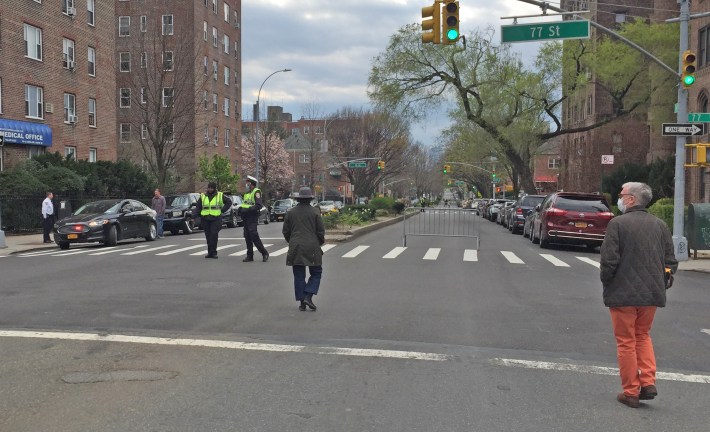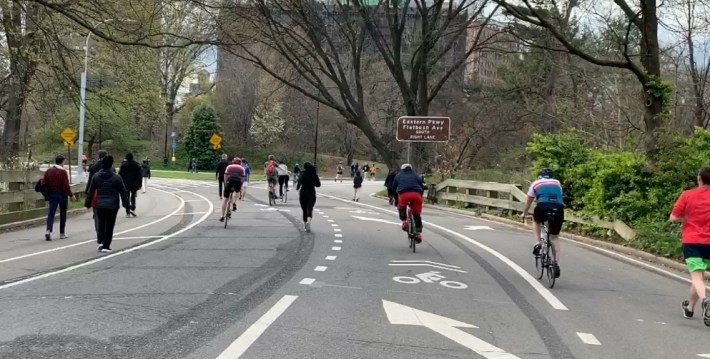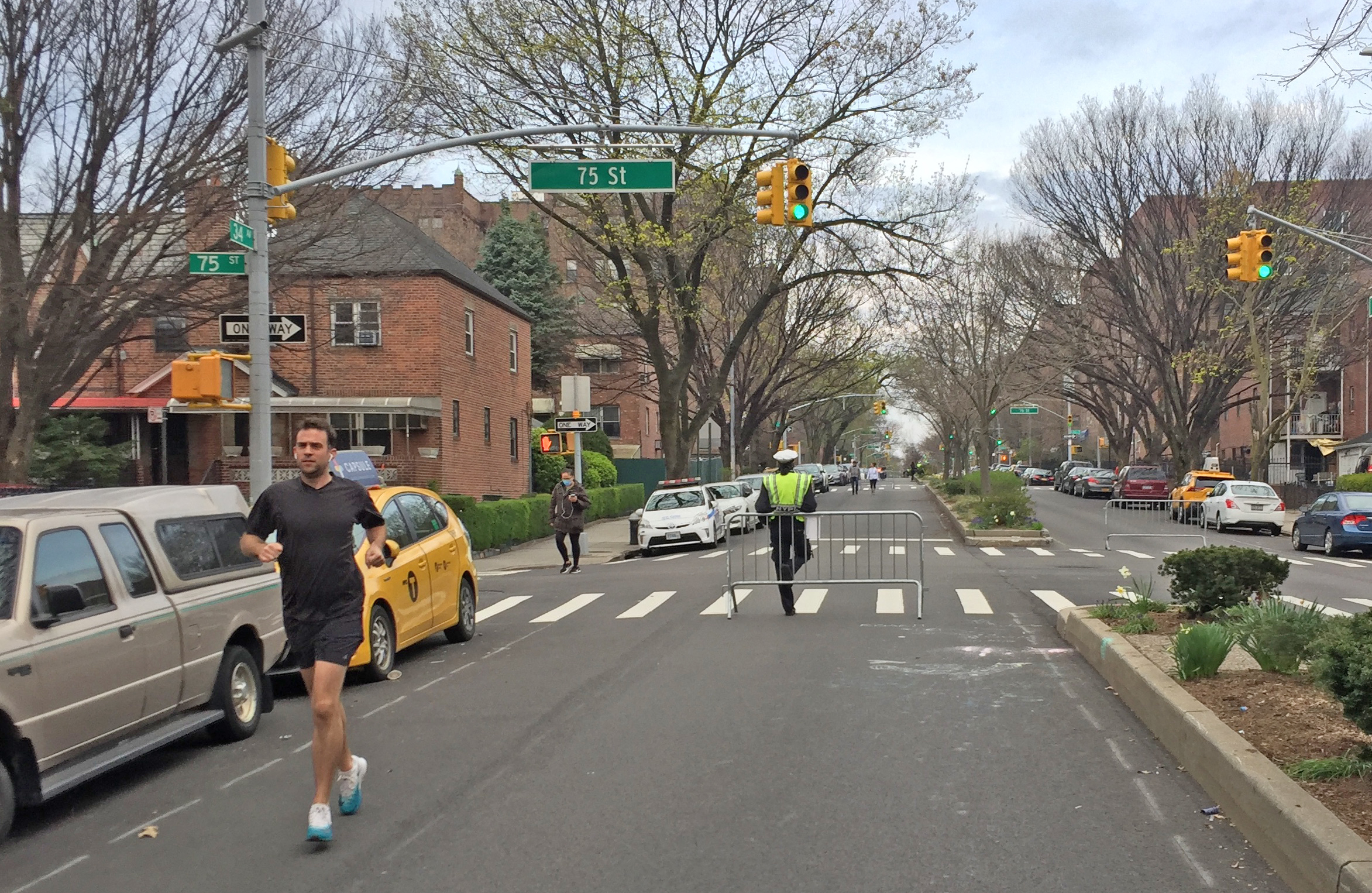The "open streets" experiment has died of overpolicing. It was 11 days old.
Mayor de Blasio said on Sunday that he can't expand his limited car-free pilot program, despite the crushing need for more open space for residents desperate to socially distance themselves, until he figures out "the right way" to do it — though he also unwittingly suggested that he had indeed been doing it the wrong way.
This de Blasio decision is just hilarious, & very him. The pilot had to be small bc the NYPD had to be able to vigorously enforce it. Few people used the small street stretches opened up but it was such a drain on the NYPD enforcing the nothing that happened that we must end it.
— Ben Max (@TweetBenMax) April 6, 2020
Responding to a question from Streetsblog at his Sunday news conference, the mayor couldn't seem to decide if converting four short stretches of roadway into open space for COVID-cramped residents was a success or a failure — and who or what would be to blame in either case.
Let's go to the audiotape. In rapid succession, de Blasio blames the weather, his misguided notion that the program needs roughly four cops per block, his unfounded concern that residents would turn the open streets into coronavirus breeding ground, and his larger conviction that open space is not something he needs to worry about right now:

Streetsblog: You know, the playgrounds are closed and parks like Prospect Park (as you know) are overflowing as the weather gets better. Now, you've experimented with four short car car-free streets, but they expire today. You've said you’re limited because of the need for police enforcement, but Streetsblog’s own review, plus conversations with residents in those neighborhoods, show that this experiment is working and could be done with far fewer cops. So will you expand this popular street safety strategy as you've been urged by people such as Dan Rather, and New York City Transit President Sarah Feinberg?
Mayor: Yeah. Gersh, look, we're very interested in seeing what can be done with that strategy. We ran into an unusual situation that just as we started it, we had day after day of bad weather and folks just didn't show up. So, I'm certain they want to see us continue to experiment with it going forward, but we have to figure out the right way to do that. It does take a lot of personnel. Like I keep saying, you know, you’ve got to be clear that when you do this, you have to create enforcement or it could end up being another place, unfortunately where people gather. So, we're going to look at that again. But right now, my concern is this, the first and foremost concern is that we focus the NYPD and other enforcement on ensuring there is social distancing in all the places that people have to go. They have to go grocery stores and supermarkets, pharmacies, the places that we know are really essential. Our parks are a place where people are going, they're getting their exercise, but they're also does need to be enforcement.

Generally, what I hear from Commissioner Shea and other key leaders of administration is they've seen a lot of compliance, but there's still areas where we need to do better and we're going to continue to deepen the enforcement. So, looking at those streets, that's still an open question because we didn't get a great control model, but we did end up using up a lot of NYPD personnel that we don't have to spare right now. So happy to look at it again. But I think we first have to focus on job one, which is making sure all the places we know people are definitely going have the enforcement they need.
That's a lot to unpack.
- "Day after day of bad weather": The first few days of the pilot program, which began on Thursday, March 26, did coincide with some rain. It's likely that "folks just didn't show up" in city parks, too, but those open spaces were still available to the public.
- "It does take a lot of personnel": Here the mayor seems to be complaining about his own decision, made in consultation with Police Commissioner Dermot Shea, that three to four cops would need to be deployed at every intersection. At one point, Streetsblog spotted 25 on the eight-block stretch of 34th Avenue in Jackson Heights, 19 cops in a seven-block stretch of Bushwick Avenue, and 22 cops in a five-block stretch of Park Avenue in Manhattan.
- Nobody goes there anymore — it's too crowded: The mayor had his own Yogi Berra moment, with comments that were internally contradictory. At one point, mayor said, "You have to create enforcement or it could end up being another place, unfortunately where people gather." But this is the same guy who said a few seconds earlier that "folks just didn't show up" — and then said a few seconds later that the open streets are not important "places that people have to go." So which is it: too crowded or not crowded at all?
- Would you just leave me alone already?: The mayor all but admitted that he's tired of having to manage open space, which he seems to think is not a crucial part of his "wartime" footing to defeat the coronavirus. "We first have to focus on job one, which is making sure all the places we know people are definitely going have the enforcement they need," he said. But a skeptic would argue that he would not need cops to break up crowds in our over-crowded parks if there were more than 1.5 miles of the city's 6,000 miles of roadway that were declared car-free.
- And, finally, the mayor seemed unaware that Streetsblog had posted a video parody about how his pilot program was hopelessly overpoliced. (Watch it here and embedded at the bottom of this post.)
So the experiment dies a quiet death. The weather is only going to improve, so it's anyone's guess where Mayor de Blasio hopes people will exercise and recreate without being all crammed together.
Like they are now:







